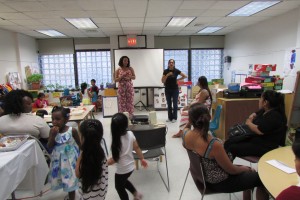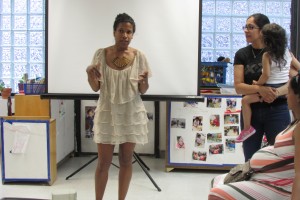
Mothers participate in a workshop with the Parent Leadership Project in Manhattan’s District 3. Photo: Courtesy of Parent Leadership Project.
The Supreme Court prohibited school segregation in 1954, in the famous case Brown vs. the Board of Education. Sixty years later, a report found that the country’s public schools are still segregated, New York City schools more than any others. A group of mothers in Harlem and other parts of Upper Manhattan are seeking to increase options so that Latino families can send their children to better schools. Diana Montaño reports. This feature story is part of American Graduate, Let’s Make it Happen!, a public media initiative to address the drop out crisis, supported by the Corporation for Public Broadcasting.
By Diana Montaño
In the Bloomingdale Family Center, a preschool Head Start center in Upper Manhattan, a group of mothers meets to discuss which schools in their district are the most welcoming to low income families of color.
These mothers are part of the Parent Leadership Project, or PLP, a community group that helps parents navigate the maze that is the public school system, beginning with the process of applying to kindergarten.
“It felt like applying to college,” said Yanuaira Lopez-Souza.
Lopez-Souza joined the group last year when she began to look for kindergarten programs for her daughter. It wasn’t easy to get into the school she wanted: PS 75 in the affluent Upper West Side neighborhood. It’s a prestigious school known for its arts program. But when Lopez-Souza applied, she was told there wasn’t room, in part because they live in another neighborhood.
“I called every day because we were on the waitlist. We called every day for two months,” said Lopez-Souza. “My husband and I took turns. I called Monday, Wednesday and Friday, and he called Tuesday and Thursday. The woman knew us by the end. In June, they accepted us because we showed we were really interested.”
According to the PLP, District 3, where Yanuaira lives, is one of the most segregated districts in the city, despite being one of the most diverse.
Aside from waiting lists, families of color in District 3 often face other barriers for entering schools where white students are concentrated. For example, the lack of translators on school tours, or the expectation that parents should raise funds, something that can alienate poor families.
Ujju Aggarwal, a professor and researcher with the City University of New York, has been studying segregation in New York City for over 10 years. She says that the Supreme Court ruling that outlawed segregation in 1954 left the process of integration incomplete.
“Brown, while it ensured equal access to schools, never established a redistribution of resources,” said Aggarwal. “And that got tied to this idea of choice. Universal rights became structured as individual choices, Instead of putting the responsibility on the district to desegregate, it puts the responsibility on the families to choose to desegregate.”
The burden of finding better schools falls on families of color, who tend to live in neighborhoods with fewer resources and underperforming schools, says Aggarwal.
This is why the PLP gives workshops to immigrant and low income parents about their rights and choices when applying to better schools.
But the PLP also wants to create structural change. They’ve joined with other groups to propose a school admissions policy called “controlled choice,” where schools are required to reflect the diversity of their community.
On the other side of the East River, in Brooklyn’s District 13, one school is already experimenting with this policy.
PS 133 is in Boerhum Hill, a neighborhood with a growing white, middle class population. Last year, the school opened its doors to students from neighboring district 15, where there are large immigrant Latino and Chinese populations. They also set aside 35% of seats for low-income kids and English language learners.
“To me it is simple: where the money is, is where the opportunities are,” said Elena Romero.
Romero came to PS 133 to pick up her daughter. She lives in Sunset Park, a Latino neighborhood in the neighboring district. Last year, she decided to change schools.
“Schools that don’t have the same funds or the same resources, are just not going to have the same opportunities,” said Romero. “So for me as a parent, I don’t care if I have to go twenty minutes by train each day, if that’s where the opportunity is for my daughter to be the best person and professional she can be, well, that’s where I’ll go.”
The demographics at PS 133 reflect the diversity of the area. On this second day of classes, Asian, Black, White and Latino students all play together after school.
Naila Rosario is president of the Community Education Council in District 15. She says PS 133’s new admissions policy has given some relief to her district’s lack of resources.
“It’s not just about diversity,” said Rosario. “There are also overpopulated schools. We are in a district, especially in the Latino areas, where schools are more than 140% overpopulated, where we have 32 kids in a class. And with this policy, what we can do is send kids to other schools that are less crowded.”
But choosing a school outside of their zone is not easy for many families. Elena Romero has to wake up at 5:30 to take her daughter on the train.
Heather Thomas Mann, the principal of PS 133, says that making the school more accessible to families who live far away continues to be a challenge.
“Are you going to provide school buses? Perhaps there needs to be some more bus routes that are put in place to ease some of the overcrowding that is in Sunset Park and where many of our dual language speakers would come from,” Mann said.
The principal says lawmakers and the Department of Education need to allocate more resources to support efforts like these.
Ujju Aggarwal, the researcher, has been working with the PLP to formulate a policy proposal on controlled choice back in District 3, in Manhattan.
“For us, desegregation isn’t necessarily the same as integration. To us it is not a solution to just have children of color sitting next to white children, but rather a redistribution of resources,” she said.
Despite the challenges, Yanuaira Lopez-Souza, the mother who had to call incessantly for two months to get into PS 75 in Manhattan, is optimistic.
“I know it’s something that is going to take a lot of time and people who are really interested and want to see change. But what can you do? Keep moving forward with the struggle, that’s the only thing we can do,” Lopez-Souza said.














